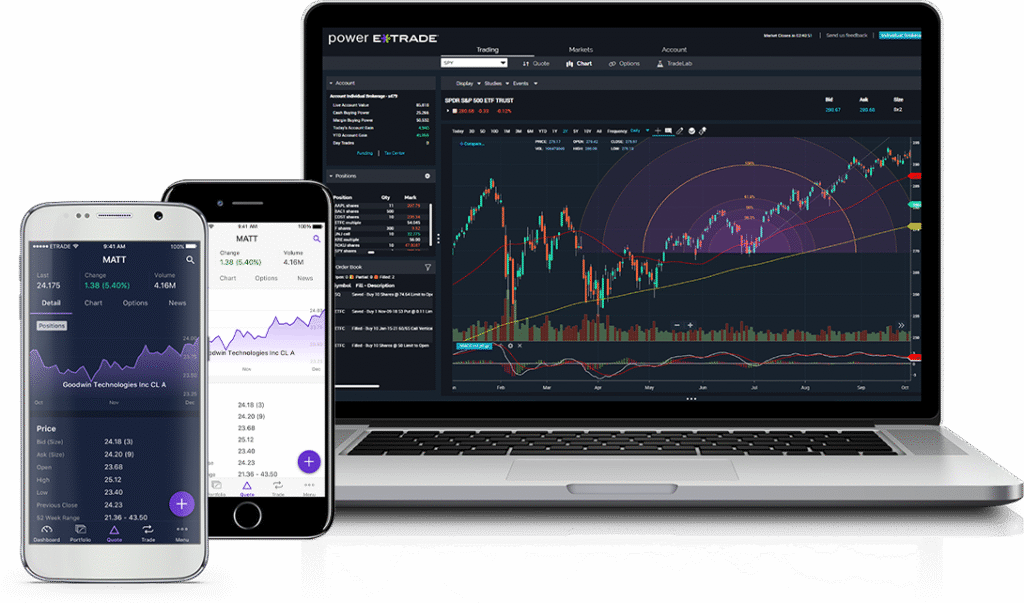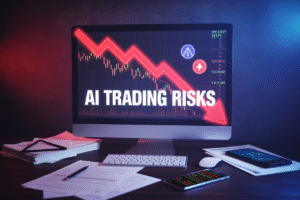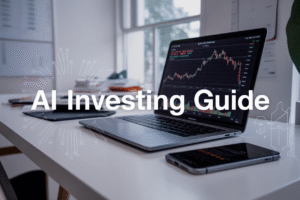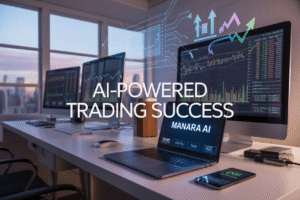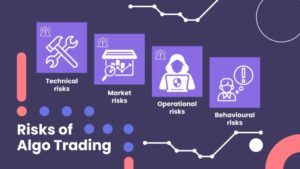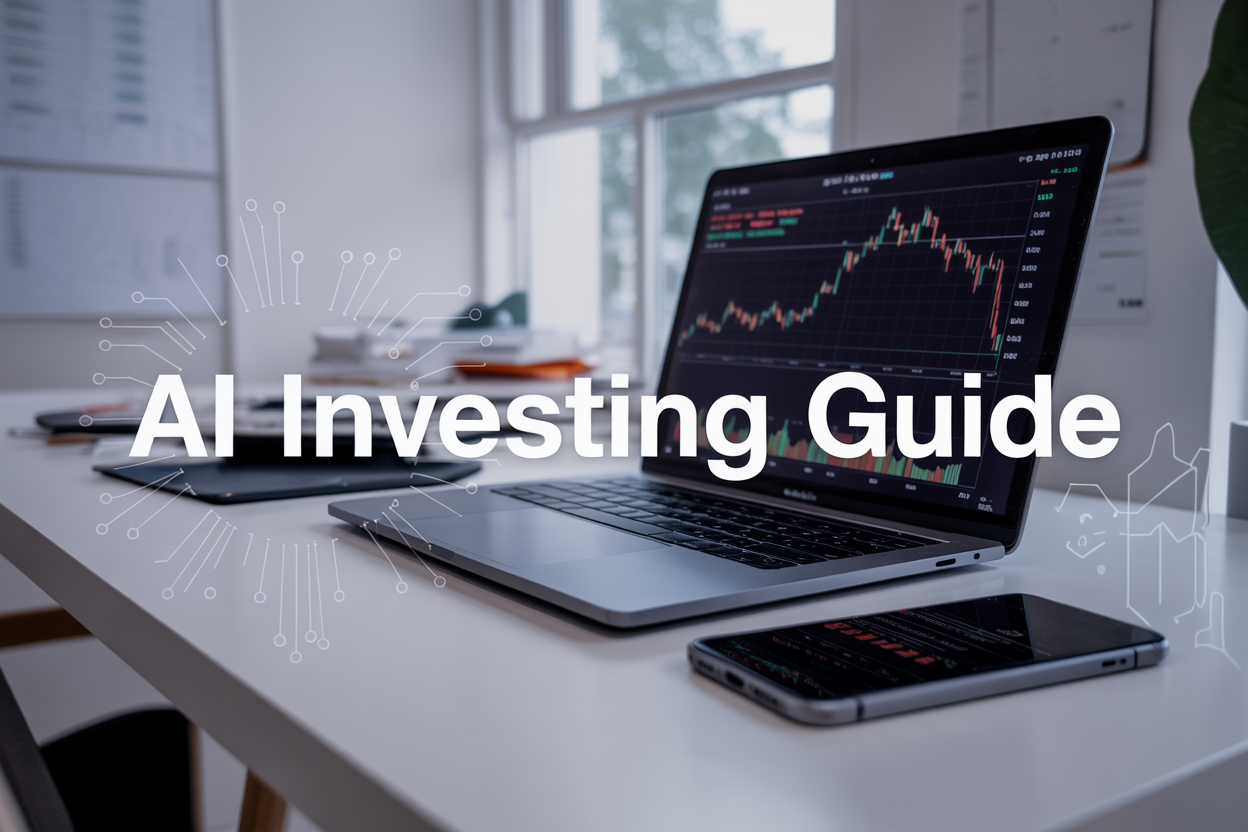
Artificial intelligence has completely changed how people invest their money, and you don’t need to be a tech expert to get started. This guide is for complete beginners who want to know if AI can actually handle their investments and how these automated tools really work.
Many new investors wonder whether robo-advisors and trading bots can replace traditional investing methods or if they’re just flashy marketing. The truth is somewhere in between, and understanding the basics will help you make smart decisions about your financial future.
We’ll break down what AI investment tools actually do and show you the real benefits they offer everyday investors. You’ll also learn about the most popular platforms available right now and get a realistic look at the risks involved. By the end, you’ll have a clear action plan for testing these tools with your own money.
Understanding AI-Powered Investment Tools
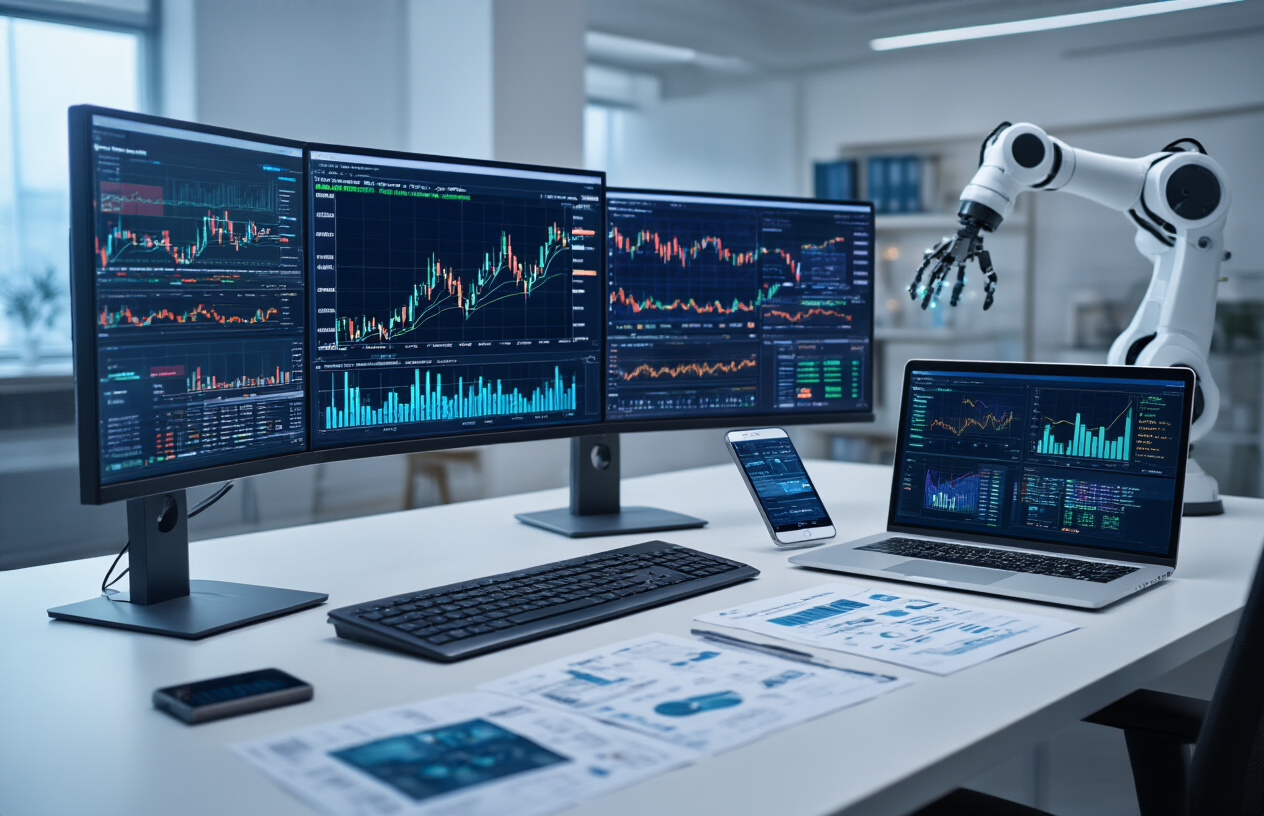
What Are Robo-Advisors and How They Automate Your Portfolio
Robo-advisors are digital platforms that manage your investment portfolio automatically using computer algorithms and software. Think of them as your digital financial advisor that works 24/7 without coffee breaks or vacation days.
When you sign up with a robo-advisor, you’ll answer questions about your financial goals, risk tolerance, and time horizon. The platform uses this information to create a personalized investment strategy, typically built around low-cost exchange-traded funds (ETFs) that track broad market indices.
The real magic happens after setup. Your robo-advisor continuously monitors your portfolio and makes adjustments automatically. If your stocks perform well and throw off your target allocation, the system will rebalance by selling some winners and buying more of the underperforming assets. This process, called rebalancing, happens without you lifting a finger.
Popular robo-advisors like Betterment, Wealthfront, and Vanguard Digital Advisor also handle tax-loss harvesting, which means they’ll strategically sell losing investments to offset gains and reduce your tax bill. They’ll reinvest dividends automatically and some even adjust your portfolio as you get closer to retirement.
The beauty of robo-advisors lies in their simplicity and consistency. They remove emotional decision-making from investing and stick to proven strategies that have worked over decades. You won’t panic-sell during market crashes or get greedy during bull runs because the algorithm keeps your investments on track.
Trading Bots Explained: Algorithmic Trading Made Simple
Trading bots are software programs that execute buy and sell orders in financial markets based on predetermined rules and algorithms. Unlike robo-advisors that focus on long-term portfolio management, trading bots are designed for more active, short-term trading strategies.
These bots analyze market data, identify patterns, and execute trades faster than any human could. They can monitor multiple markets simultaneously, processing thousands of data points per second to spot opportunities that might last only minutes or even seconds.
Trading bots come in various flavors. Some focus on arbitrage, buying and selling the same asset across different exchanges to profit from price differences. Others use technical analysis, looking for chart patterns, moving average crossovers, or momentum signals to trigger trades. More sophisticated bots incorporate machine learning algorithms that adapt their strategies based on market conditions and past performance.
The speed advantage is huge. While you’re still processing news about a company’s earnings report, a trading bot has already analyzed the information, compared it to historical patterns, and executed trades across multiple positions. This speed can be the difference between profit and loss in fast-moving markets.
However, trading bots require much more hands-on management than robo-advisors. You need to understand the underlying strategies, monitor performance closely, and adjust parameters as market conditions change. Many retail trading bots are available through platforms like 3Commas, Cryptohopper, and TradeSanta, particularly for cryptocurrency markets.
Key Differences Between Robo-Advisors and Trading Bots
The fundamental difference between robo-advisors and trading bots comes down to investment philosophy and time horizon. Robo-advisors are marathon runners built for long-term wealth building, while trading bots are sprinters designed for short-term profit opportunities.
| Aspect | Robo-Advisors | Trading Bots |
| Investment Approach | Passive, buy-and-hold strategy | Active trading strategies |
| Time Horizon | Long-term (5+ years) | Short-term (minutes to months) |
| Risk Level | Moderate, diversified risk | Higher risk, concentrated positions |
| User Involvement | Minimal after setup | Regular monitoring required |
| Trading Frequency | Occasional rebalancing | High-frequency trading |
| Target Audience | Beginning to intermediate investors | Experienced traders |
Robo-advisors prioritize steady, consistent growth through diversified portfolios. They’re perfect for people who want to invest regularly without thinking about it daily. Your robo-advisor might make a dozen trades per year, mainly for rebalancing or tax optimization.
Trading bots operate in a completely different world. They might execute hundreds or thousands of trades per day, trying to capture small price movements across various assets. This approach can generate higher returns in the right market conditions, but it also comes with significantly higher risk.
The fee structures also differ dramatically. Robo-advisors typically charge annual management fees between 0.25% and 0.50% of your account balance. Trading bots might have subscription fees, performance fees, or charge per trade, which can add up quickly if you’re making frequent transactions.
Another major difference is regulatory oversight. Robo-advisors are typically regulated as investment advisors and must follow strict fiduciary standards. Trading bot platforms often operate with less regulatory oversight, especially in cryptocurrency markets, which means you have fewer protections if something goes wrong.
Benefits of Using AI for Your Investment Strategy
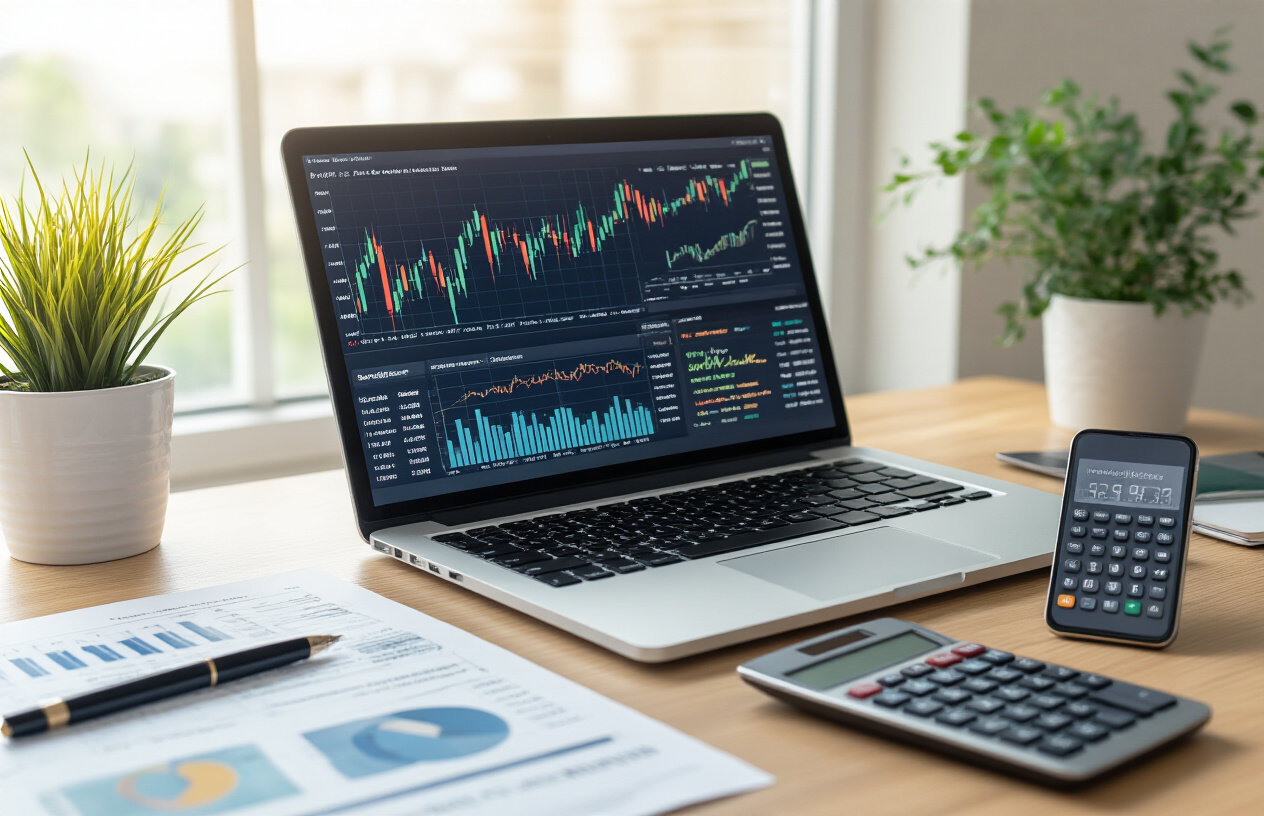
Lower Fees Compared to Traditional Financial Advisors
Traditional financial advisors typically charge between 1% to 2% annually on your assets under management, which can eat away thousands of dollars from your portfolio over time. AI-powered investment platforms slash these costs dramatically, with most robo-advisors charging between 0.25% to 0.50% per year. Some platforms like M1 Finance even offer free automated investing with no management fees whatsoever.
Consider this: On a $100,000 portfolio, you’d pay $1,000 to $2,000 annually to a human advisor versus just $250 to $500 for a robo-advisor. Over 20 years, that difference compounds to tens of thousands in saved fees that stay in your account and continue growing.
The lower cost structure exists because AI eliminates the need for expensive human labor in portfolio management, office overhead, and lengthy client meetings. Algorithms can manage thousands of portfolios simultaneously without the operational costs that drive up traditional advisory fees.
Emotion-Free Decision Making That Protects Your Wealth
Human psychology often works against successful investing. Fear drives people to sell during market downturns, while greed pushes them to chase hot stocks at market peaks. These emotional reactions destroy long-term wealth building more than any other factor.
AI systems don’t experience fear, panic, or FOMO. When markets crash 20%, your robo-advisor continues following its programmed strategy without the urge to sell everything and hide in cash. When certain sectors skyrocket, it doesn’t get swept up in bubble mentality and overweight speculative investments.
This emotional discipline proves especially valuable during major market events. During the COVID-19 market crash of March 2020, many human investors panicked and sold near the bottom, missing the rapid recovery that followed. AI systems that maintained their asset allocations captured the full rebound, protecting and growing their clients’ wealth.
The algorithms stick to proven investment principles like dollar-cost averaging, systematic rebalancing, and maintaining target asset allocations regardless of market noise or media headlines screaming about impending doom or unprecedented opportunities.
24/7 Market Monitoring and Instant Portfolio Adjustments
Financial markets never sleep, with trading happening around the clock across global exchanges. While human advisors work standard business hours, AI systems monitor your portfolio continuously, ready to respond to significant market movements or rebalancing opportunities.
This constant vigilance means your portfolio stays optimally positioned without delays. If your target allocation calls for 60% stocks and 40% bonds, but a market rally pushes your stock allocation to 65%, the AI can immediately rebalance back to your target. Human advisors might not notice this drift for weeks or months.
AI systems also process vast amounts of market data instantaneously. They can analyze economic indicators, earnings reports, interest rate changes, and geopolitical events simultaneously, adjusting your portfolio based on these inputs far faster than any human could process the same information.
Some advanced platforms even monitor for tax-loss harvesting opportunities daily, automatically selling losing positions to offset gains and reduce your tax burden. This level of ongoing optimization would be prohibitively expensive if done manually by a human advisor.
Access to Professional Investment Strategies for Small Accounts
Traditionally, sophisticated investment strategies like Modern Portfolio Theory, factor-based investing, and tax-loss harvesting were reserved for wealthy clients with millions in assets. Minimum account requirements at premium advisory firms often started at $250,000 to $1 million.
AI democratizes these professional strategies, making them available to investors with as little as $1 to start. Robo-advisors use the same mathematical models and portfolio optimization techniques that institutional investors have relied on for decades.
You gain access to diversified portfolios using low-cost ETFs that provide exposure to thousands of stocks and bonds worldwide. The AI automatically handles asset allocation, rebalancing, and tax optimization using algorithms developed by teams of PhD economists and quantitative analysts.
| Strategy Type | Traditional Minimum | Robo-Advisor Minimum |
| Tax-Loss Harvesting | $500,000+ | $5,000-$50,000 |
| Factor-Based Investing | $1,000,000+ | $100-$500 |
| Global Diversification | $250,000+ | $1-$10 |
| Automatic Rebalancing | $100,000+ | No minimum |
This leveling of the playing field means beginning investors can implement the same wealth-building strategies that previously required substantial assets and high fees to access through traditional advisory relationships.
Popular AI Investment Platforms You Should Know
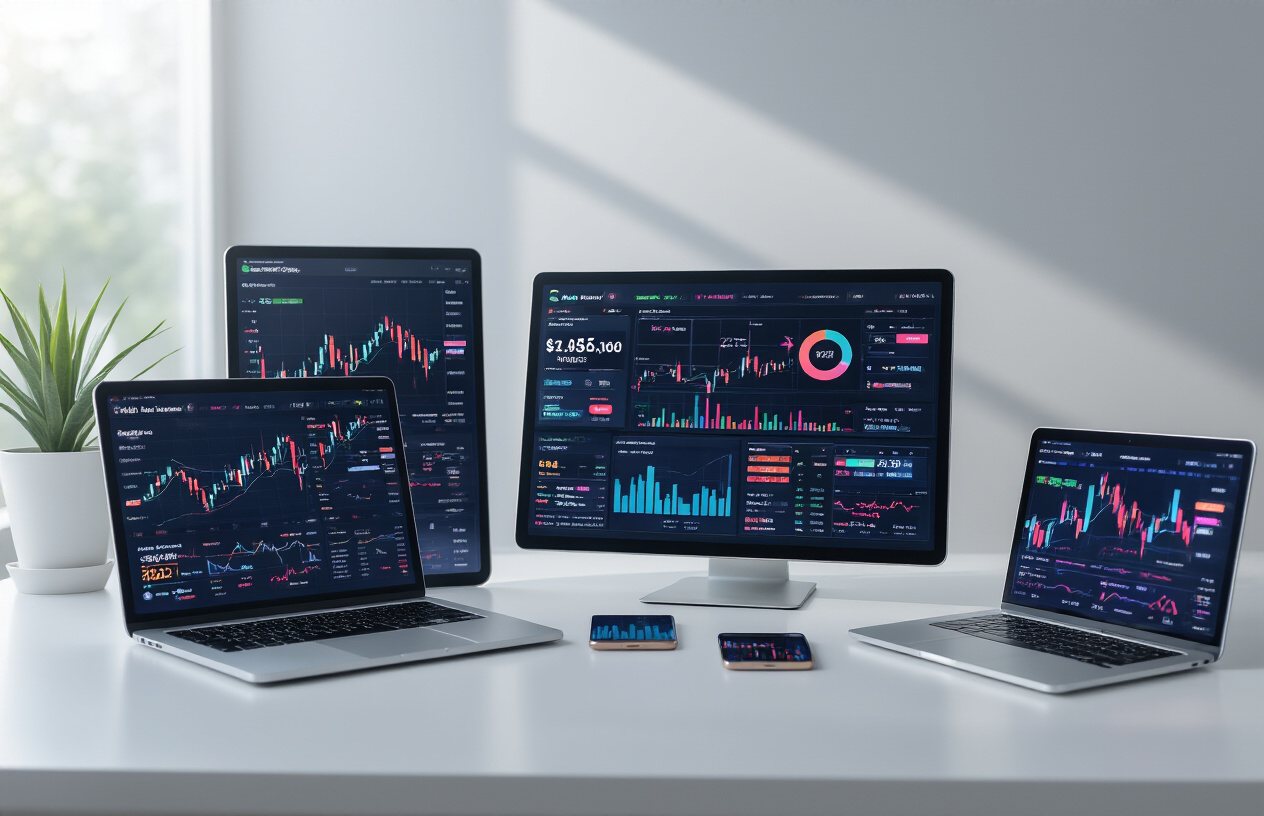
Leading Robo-Advisor Services and Their Unique Features
Betterment stands as one of the most beginner-friendly robo-advisors, offering automated rebalancing and tax-loss harvesting for accounts over $10,000. What sets Betterment apart is its goal-based investing approach, where you can set up separate portfolios for different objectives like retirement or a home down payment. The platform uses low-cost ETFs and adjusts your portfolio’s risk level based on your timeline.
Wealthfront takes a more sophisticated approach with its advanced tax-loss harvesting and direct indexing for larger accounts. The platform automatically handles dividend reinvestment and offers features like portfolio line of credit for high-net-worth clients. Wealthfront’s daily tax-loss harvesting can potentially add significant after-tax returns over time.
M1 Finance combines robo-advisor automation with the flexibility of choosing your own investments. You can create custom “pie charts” of stocks and ETFs, and M1 automatically rebalances your portfolio and reinvests dividends according to your chosen allocations. This hybrid approach appeals to investors who want some control while maintaining automation.
Schwab Intelligent Portfolios requires a $5,000 minimum but charges no advisory fees, making money through the cash allocation in portfolios and expense ratios on their ETFs. The platform offers automatic rebalancing and tax-loss harvesting, with access to human advisors for accounts over $25,000.
Top Trading Bot Platforms for Different Experience Levels
For complete beginners, Acorns provides the gentlest introduction to automated investing through its micro-investing approach. The app rounds up your purchases to the nearest dollar and invests the spare change in diversified portfolios. While not technically a trading bot, it automates investment decisions and removes the complexity of choosing individual investments.
3Commas caters to cryptocurrency traders with its sophisticated bot ecosystem. The platform offers various bot types including DCA (Dollar Cost Averaging) bots, Grid bots, and Options bots. Users can copy successful trading strategies from other traders or create their own automated strategies. The interface requires some learning but provides extensive customization options for intermediate to advanced users.
TradeSanta focuses specifically on cryptocurrency trading with pre-built bot templates that work across multiple exchanges like Binance and Coinbase Pro. The platform offers both long and short bots, with features like trailing stop-loss and take-profit orders. Their bot templates make it easier for newcomers to start automated crypto trading without deep technical knowledge.
For stock market automation, Trade Ideas provides AI-powered stock scanning and alerts rather than direct trading execution. The platform’s Holly AI analyzes market patterns and generates trade ideas based on technical analysis. While you still need to execute trades manually, it automates the research and identification process.
Interactive Brokers’ IBKR Algo platform serves advanced traders with sophisticated algorithmic trading tools. The platform supports various order types including TWAP, VWAP, and arrival price algorithms. This option requires significant trading knowledge but offers institutional-level automation capabilities.
Cost Comparison: Finding the Most Affordable Options
| Platform | Annual Fee | Minimum Investment | Additional Costs |
| Betterment | 0.25% | $0 | ETF expense ratios (0.05-0.25%) |
| Wealthfront | 0.25% | $500 | ETF expense ratios (0.05-0.25%) |
| M1 Finance | 0% | $100 | ETF expense ratios only |
| Schwab Intelligent | 0% | $5,000 | ETF expense ratios (0.03-0.25%) |
| 3Commas | $14.50-$49.50/month | Varies by exchange | Exchange trading fees |
| TradeSanta | $14-$50/month | Varies by exchange | Exchange trading fees |
| Acorns | $3/month | $0 | ETF expense ratios |
The most cost-effective option depends on your account size and trading frequency. For small accounts under $10,000, Acorns’ flat monthly fee becomes expensive relative to your balance, while percentage-based fees from Betterment or Wealthfront stay proportional. M1 Finance offers the best deal for hands-off investors who don’t need extensive guidance, charging zero management fees.
For cryptocurrency trading bots, monthly subscription costs add up quickly. A $30 monthly subscription equals $360 annually, which means you need a substantial crypto portfolio to justify the expense. Calculate whether the bot’s potential returns exceed these fixed costs plus exchange trading fees.
Hidden costs include expense ratios on underlying investments, which typically range from 0.03% to 0.25% annually. Some platforms like Schwab keep cash allocations in portfolios to generate revenue, which can drag down returns during bull markets. Always factor in total costs rather than just the advertised management fee when comparing platforms.
Risks and Limitations of Automated Investing

Market Volatility Can Still Impact AI-Managed Portfolios
AI systems excel at processing vast amounts of data and identifying patterns, but they can’t predict or prevent market crashes. When the COVID-19 pandemic hit in March 2020, even the most sophisticated robo-advisors watched portfolios plummet alongside human-managed accounts. The algorithms couldn’t foresee this unprecedented global event any better than seasoned fund managers.
Market volatility affects AI-managed portfolios through several channels. During high-stress periods, correlations between different asset classes often increase, meaning diversification strategies that work in normal times may fail when you need them most. AI systems might also struggle with “black swan” events – rare but impactful occurrences that fall outside their training data.
Robo-advisors typically use modern portfolio theory and historical data to make decisions. However, past performance doesn’t guarantee future results, and AI systems can be blindsided by sudden shifts in market sentiment, regulatory changes, or geopolitical events that don’t fit historical patterns.
Technology Failures and Platform Downtime Concerns
Your investment strategy becomes vulnerable when it depends entirely on technology. Server outages, software bugs, or cyber attacks can prevent you from accessing your account or executing trades at critical moments. During the GameStop trading frenzy in early 2021, several major trading platforms experienced outages that locked users out during peak volatility.
Internet connectivity issues on your end can also create problems. If your robo-advisor needs to rebalance your portfolio but can’t connect to execute trades, you might miss important market movements. Some platforms offer mobile apps as backup, but these aren’t foolproof either.
Data feed errors represent another technical risk. If an AI system receives incorrect market data, it could make faulty investment decisions based on bad information. While most platforms have safeguards, these failures do occur and can impact your returns.
Limited Customization for Complex Financial Goals
Most robo-advisors work best for straightforward investment objectives like retirement savings or general wealth building. They struggle with complex scenarios that require nuanced decision-making. If you’re planning for a child’s education, managing inheritance taxes, or coordinating investments with a business ownership structure, basic AI tools often fall short.
Tax-loss harvesting, while offered by many platforms, may not align with your specific tax situation. The AI might sell investments to realize losses without considering how this affects your overall tax strategy or other accounts you manage separately.
Personal circumstances change frequently – job loss, divorce, inheritance, or health issues – and AI systems aren’t equipped to understand these life events’ emotional and financial implications. They can’t have the meaningful conversations that help adjust your strategy when major life changes occur.
The Importance of Understanding What Your AI Is Doing
Many investors treat robo-advisors like “set it and forget it” solutions, but this hands-off approach can be dangerous. You need to understand your AI’s investment philosophy, risk assessment methods, and rebalancing triggers. Without this knowledge, you might panic during market downturns or make poor decisions that counteract your automated strategy.
AI systems make hundreds of micro-decisions about your portfolio, but they can’t explain their reasoning in intuitive terms. When your account value drops significantly, you want to understand why specific investments were chosen and how the system plans to respond. This transparency gap can lead to anxiety and poor investment behavior.
Regular monitoring remains essential even with automated investing. You should review your risk tolerance annually, understand fee structures, and ensure your AI’s asset allocation still matches your goals. Blind faith in technology, regardless of how sophisticated, rarely leads to optimal financial outcomes.
Getting Started: Your Step-by-Step Action Plan

Assessing Your Risk Tolerance and Investment Goals
Before diving into any AI investment platform, take a moment to understand yourself as an investor. Your risk tolerance isn’t just about how much money you can afford to lose—it’s about how you’ll sleep at night when markets get bumpy.
Start by asking yourself some honest questions: Are you someone who checks their portfolio daily, or do you prefer a “set it and forget it” approach? Can you handle watching your account value drop 20% without panicking and selling everything? Your answers will shape which AI tools work best for you.
Conservative investors typically feel comfortable with 10-15% stock allocation, while aggressive investors might go 90% or higher. Most people fall somewhere in between. Consider your age, income stability, and how long you have until you need this money. A 25-year-old saving for retirement can weather much more volatility than someone planning to buy a house in two years.
Your investment goals matter just as much. Are you building wealth for retirement, saving for a down payment, or trying to generate passive income? Different AI platforms excel at different objectives. Some focus on long-term growth, others on income generation, and some on tax optimization.
Write down your specific goals with dollar amounts and timelines. “I want to save $50,000 for a house down payment in five years” gives an AI system much clearer direction than “I want to make money.”
Choosing the Right Platform Based on Your Needs
The AI investment landscape offers something for everyone, but not every platform suits every investor. Your choice should align with your goals, experience level, and preferences you identified earlier.
For hands-off investors who want professional-grade portfolio management, traditional robo-advisors like Betterment or Wealthfront make excellent choices. They handle asset allocation, rebalancing, and tax-loss harvesting automatically. These platforms typically charge 0.25-0.50% annually and work best for long-term investors.
If you’re interested in more active involvement, consider platforms like M1 Finance, which blends robo-advisor features with self-directed investing. You can create custom portfolios or choose from expert-built “pies,” then let the AI handle rebalancing and fractional share investing.
Tech-savvy investors might gravitate toward newer platforms like Schwab Intelligent Portfolios or Fidelity Go, which offer robust AI features backed by major financial institutions. These often come with lower fees and access to human advisors when needed.
For those interested in AI-powered stock picking rather than just portfolio management, platforms like Tickeron or Trade Ideas use machine learning to identify potential trades. However, these require more active management and carry higher risks.
Compare key factors across platforms:
| Feature | Traditional Robo | Hybrid Platforms | AI Trading Tools |
| Fees | 0.25-0.50% | 0.00-0.35% | $30-200/month |
| Minimum | $0-500 | $0-100 | $500-5,000 |
| Control Level | Low | Medium | High |
| Time Commitment | Minimal | Low-Medium | High |
NEED A PLATFORM TO START?
Manara Ai got you covered all you need to do is pick a subscription package and let us do the work for you.
Setting Up Your Account and Initial Funding Requirements
Getting started with your chosen platform is straightforward, but preparation makes the process smoother. Gather necessary documents beforehand: driver’s license, Social Security number, bank account information, and employment details.
Most platforms require basic personal information, investment experience questions, and risk tolerance assessments. Answer these honestly—the AI uses your responses to build your initial portfolio allocation. You can always adjust settings later as your situation changes.
Funding requirements vary dramatically. Many robo-advisors now offer zero minimums, making them accessible to new investors. However, some premium features like tax-loss harvesting might require $10,000 or more. Don’t let low minimums fool you into thinking you need to start small—larger initial deposits often unlock better features and lower percentage fees.
Consider your funding source carefully. Transferring money from savings accounts is simple and fast, usually taking 3-5 business days. Rolling over an existing 401(k) or IRA takes longer but can jumpstart your AI-managed portfolio with a substantial balance.
Set up automatic transfers to keep your investment plan on track. Most platforms allow you to schedule weekly, bi-weekly, or monthly deposits. Even $50 weekly adds up to $2,600 annually and takes advantage of dollar-cost averaging.
Review account settings before activating AI features. Enable notifications for large market moves or rebalancing activities, but avoid daily performance alerts that might tempt you to micromanage. Remember, you chose AI investing to remove emotion from the equation—let it do its job.

AI-powered investment tools have opened up exciting new possibilities for everyday investors. Robo-advisors offer hands-off portfolio management with low fees, while trading bots can execute strategies around the clock. These platforms make investing more accessible and remove emotional decision-making from the equation. However, they’re not magic money-makers – you still need to understand the risks, fees, and limitations that come with automated investing.
The key is finding the right balance between convenience and control. Start small with a reputable platform, keep learning about investing basics, and don’t put all your eggs in one automated basket. AI can be a powerful ally in building your wealth, but it works best when you stay engaged and informed about where your money is going. Take the time to research different platforms, understand their strategies, and choose one that matches your financial goals and risk tolerance.

